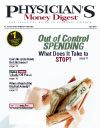Publication
Article
Physician's Money Digest
Investing as Easy as a Flip of the Coin?
Author(s):
Money management, in essence,is about deciding howmuch of your equity youshould risk on any given trade. Whatmany physician-investors aren't awareof is that there is a strong correlationbetween the long-term result of a seriesof trades and the amount of risk takenon a per-trade basis.
Take into account the following coin-flippinggame that has a positiveexpectancy. A coin will be flipped in theair 100 times. You have $100 withwhich to bet. Every time the coin landsheads up, you win $2. Every time thecoin lands tails up, you lose $1. You'llneed to determine how much youshould bet on each flip of the coin,assuming that heads will land up 50%of the time and tails will land up 50% ofthe time—what percentage of your totalaccount should be placed on each bet fora maximum return?
This example is a mathematicallypositive expectancy game, because youwill have 50 heads and 50 tails, andthe profit of $2 when you win is morethan your loss of $1. The followingchart approximates the results of yourreturn after betting a specific percentageof your total account:
If you start with $100, betting 25%of your total account on each bet willcreate the greatest return of $36,100.Keep in mind that the optimal amountto risk applies to this example only. It isintended to show that every investorshould consider proper trade sizingapproaches to their investing discipline.
If you risk too little on each trade, thereturns will be too low. If you risk more,the returns will increase, but note thatthe potential drawdown always increasesas you increase the per-trade risk.Returns continue to increase movinginto the overtrading zone, as you getcloser to risking 25% of the account—after that mark, returns decrease.
Trading at the peak of the potentialreturn curve can be difficult psychologically,because the margin of safety fordealing with unexpectedly high losingtrades is very low. The place to be on thiscurve is the spot where you can dealwith the risk. Most good traders do notrisk more than 1% to 2% of their totalaccount equity on any given trade. Andthey have the discipline to apply theirinvesting methodology at all times.
Michael Doran is a private money manageraffiliated with Sierra Capital Planning innorthern California. He runs a fee-basedbusiness and a hedge fund for qualified investors.For more information, call 877-467-8657 or visit www.sierrainvestor.com. Avinash Agrawal contributesto stock research and wealth management at SierraCapital Planning Inc.
